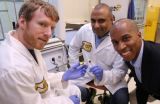(Press-News.org) VIDEO:
This video shows a numerical simulation of Earth's deep mantle. The top panel is temperature and the bottom panel is composition which includes three components: the more-primitive reservoir at the...
Click here for more information.
TEMPE, Ariz. – Seeking to better understand the composition of the lowermost part of Earth's mantle, located nearly 2,900 kilometers (1,800 miles) below the surface, a team of Arizona State University researchers has developed new simulations that depict the dynamics of deep Earth. A paper published March 30 in Nature Geoscience reports the team's findings, which could be used to explain the complex geochemistry of lava from hotspots such as Hawaii.
Mantle convection is the driving force behind continental drift and causes earthquakes and volcanoes on the surface. Through mantle convection, material from the lowermost part of Earth's mantle could be carried up to the surface, which offers insight into the composition of the deep Earth. The Earth's core is very hot (~4000 K) and rocks at the core mantle boundary are heated and expand to have a lower density. These hot rocks (also called mantle plumes) could migrate to the surface because of buoyancy.
Observations, modeling and predictions have indicated that the deepest mantle is compositionally complex and continuously churning and changing.
"The complex chemical signatures of hotspot basalts provide evidence that the composition of the lowermost part of Earth's mantle is different from other parts. The main question driving this research is how mantle plumes and different compositional components in Earth's mantle interact with each other, and how that interaction leads to the complex chemistry of hotspot basalts. The answer to this question is very important for us to understand the nature of mantle convection," explains lead author Mingming Li, who is pursuing his Ph.D. in geological sciences.
"Obviously, we cannot go inside of the Earth to see what is happening there. However, the process of mantle convection should comply with fundamental physics laws, such as conservation of mass, momentum and energy. What we have done is to simulate the process of mantle convection by solving the equations which controls the process of mantle convection," says Li.
It has long been suggested that the Earth's mantle contains several different compositional reservoirs, including an ancient more-primitive reservoir at the lowermost mantle, recycled oceanic crust and depleted background mantle. The complex geochemistry of lava found at hotspots such as Hawaii are evidence of this. The various compositional components in hotspot lava may be derived from these different mantle reservoirs. The components could become embedded in and carried to the surface by mantle plumes, but it is unclear how individual plumes could successively sample each of these reservoirs.
Joined by his advisor Allen McNamara, geodynamicist and associate professor in Arizona State University's School of Earth and Space Exploration, and seismologist and SESE professor Ed Garnero, Li and his collaborators' numerical experiments show that plumes can indeed carry a combination of different materials from several reservoirs.
According to the simulations, some subducted oceanic crust is entrained directly into mantle plumes, but a significant fraction of the crust—up to 10%—enters the more primitive reservoirs. As a result, mantle plumes entrain a variable combination of relatively young oceanic crust directly from the subducting slab, older oceanic crust that has been stirred with ancient more primitive material and background, depleted mantle. Cycling of oceanic crust through mantle reservoirs can therefore explain observations of different recycled oceanic crustal ages and explain the chemical complexity of hotspot lavas.
"Our calculations take a long time – more than one month for one calculation – but the results are worth it," says Li.
INFORMATION: END
Earth's dynamic interior
Researchers' model reveals multiple compositional components of Earth's deep mantle being carried up to the surface
2014-03-30
ELSE PRESS RELEASES FROM THIS DATE:
Heat-conducting polymer cools hot electronic devices at 200 degrees C
2014-03-30
Polymer materials are usually thermal insulators. But by harnessing an electropolymerization process to produce aligned arrays of polymer nanofibers, researchers have developed a thermal interface material able to conduct heat 20 times better than the original polymer. The modified material can reliably operate at temperatures of up to 200 degrees Celsius.
The new thermal interface material could be used to draw heat away from electronic devices in servers, automobiles, high-brightness LEDs and certain mobile devices. The material is fabricated on heat sinks and heat ...
Scientists pinpoint why we miss subtle visual changes, and why it keeps us sane
2014-03-30
Ever notice how Harry Potter's T-shirt abruptly changes from a crewneck to a henley shirt in "The Order of the Phoenix," or how in "Pretty Woman," Julia Roberts' croissant inexplicably morphs into a pancake? Don't worry if you missed those continuity bloopers. Vision scientists at the University of California, Berkeley, and the Massachusetts Institute of Technology have discovered an upside to the brain mechanism that can blind us to subtle changes in movies and in the real world.
They've discovered a "continuity field" in which the brain visually merges similar objects ...
A new approach to Huntington's disease?
2014-03-30
Tweaking a specific cell type's ability to absorb potassium in the brain improved walking and prolonged survival in a mouse model of Huntington's disease, reports a UCLA study published March 30 in the online edition of Nature Neuroscience. The discovery could point to new drug targets for treating the devastating disease, which strikes one in every 20,000 Americans.
Huntington's disease is passed from parent to child through a mutation in the huntingtin gene. By killing brain cells called neurons, the progressive disorder gradually deprives patients of their ability ...
Erasing a genetic mutation
2014-03-30
CAMBRIDGE, MA -- Using a new gene-editing system based on bacterial proteins, MIT researchers have cured mice of a rare liver disorder caused by a single genetic mutation.
The findings, described in the March 30 issue of Nature Biotechnology, offer the first evidence that this gene-editing technique, known as CRISPR, can reverse disease symptoms in living animals. CRISPR, which offers an easy way to snip out mutated DNA and replace it with the correct sequence, holds potential for treating many genetic disorders, according to the research team.
"What's exciting about ...
Effect of important air pollutants may be absent from key precipitation observations
2014-03-30
Pioneering new research from the University of Exeter could have a major impact on climate and environmental science by drastically transforming the perceived reliability of key observations of precipitation, which includes rain, sleet and snow.
The ground breaking study examines the effect that increased aerosol concentrations in the atmosphere, emitted as a result of burning fossil fuels, had on regional temperature and precipitation levels.
Scientists from Exeter's Mathematics department compared observed regional temperature and precipitation changes throughout ...
Genetic mutations warn of skin cancer risk
2014-03-30
Researchers have discovered that mutations in a specific gene are responsible for a hereditary form of melanoma.
Every year in the UK, almost 12,000 people are diagnosed with melanoma, a form of skin cancer. About 1 in 20 people with melanoma have a strong family history of the disease. In these patients, pinpointing the genetic mutations that drive disease development allows dermatologists to identify people who should be part of melanoma surveillance programmes.
The team found that people with specific mutations in the POT1 gene were extremely likely to develop melanoma. ...
Scripps Florida scientists offer 'best practices' nutrition measurement for researchers
2014-03-30
JUPITER, FL, March 30, 2014 – At first glance, measuring what the common fruit fly eats might seem like a trivial matter, but it is absolutely critical when it comes to conducting studies of aging, health, metabolism and disease. How researchers measure consumption can make all the difference in the accuracy of a study's conclusions.
Scientists from the Florida campus of The Scripps Research Institute (TSRI) have developed what amounts to a best practices guide to the most accurate way of measuring fruit fly food consumption that could lead to more informed research and ...
Researchers identify new protein markers that may improve understanding of heart disease
2014-03-30
Researchers at the Intermountain Medical Center Heart Institute in Murray, Utah, have discovered that elevated levels of two recently identified proteins in the body are inflammatory markers and indicators of the presence of cardiovascular disease.
These newly identified markers of inflammation, GlycA and GlycB, have the potential to contribute to better understanding of the inflammatory origins of heart disease and may be used in the future to identify a heart patient's future risk of suffering a heart attack, stroke, or even death.
Inflammation occurs in the body ...
Study compares heart valve systems
2014-03-30
Among patients undergoing aortic valve replacement using a catheter tube, a comparison of two types of heart valve technologies, balloon-expandable or self-expandable valve systems, found a greater rate of device success with the balloon-expandable valve, according to a JAMA study released online to coincide with presentation at the 2014 American College of Cardiology Scientific Sessions.
Transcatheter aortic valve replacement (TAVR) has emerged as a new option for patients with severe narrowing of the aortic valve and as an effective alternative treatment method to ...
Medication does not reduce risk of recurrent CV events among patients with diabetes
2014-03-30
Use of the drug aleglitazar, which has shown the ability to lower glucose levels and have favorable effects on cholesterol, did not reduce the risk of cardiovascular death, heart attack or stroke among patients with type 2 diabetes and recent heart attack or unstable angina, according to a JAMA study released online to coincide with presentation at the 2014 American College of Cardiology Scientific Sessions.
Cardiovascular disease remains the dominant cause of death among patients with type 2 diabetes. No drug therapy specifically directed against diabetes nor strategy ...
LAST 30 PRESS RELEASES:
Survey reveals ethical gaps slowing AI adoption in pediatric surgery
Stimulant ADHD medications work differently than thought
AI overestimates how smart people are, according to HSE economists
HSE researchers create genome-wide map of quadruplexes
Scientists boost cell "powerhouses" to burn more calories
Automatic label checking: The missing step in making reliable medical AI
Low daily alcohol intake linked to 50% heightened mouth cancer risk in India
American Meteorological Society announces Rick Spinrad as 2026 President-Elect
Biomass-based carbon capture spotlighted in newly released global climate webinar recording
Illuminating invisible nano pollutants: advanced bioimaging tracks the full journey of emerging nanoscale contaminants in living systems
How does age affect recovery from spinal cord injury?
Novel AI tool offers prognosis for patients with head and neck cancer
Fathers’ microplastic exposure tied to their children’s metabolic problems
Research validates laboratory model for studying high-grade serous ovarian cancer
SIR 2026 delivers transformative breakthroughs in minimally invasive medicine to improve patient care
Stem Cell Reports most downloaded papers of 2025 highlight the breadth and impact of stem cell research
Oxford-led study estimates NHS spends around 3% of its primary and secondary care budget on the health impacts of heat and cold in England
A researcher’s long quest leads to a smart composite breakthrough
Urban wild bees act as “microbial sensors” of city health.
New study finds where you live affects recovery after a hip fracture
Forecasting the impact of fully automated vehicle adoption on US road traffic injuries
Alcohol-related hospitalizations from 2016 to 2022
Semaglutide and hospitalizations in patients with obesity and established cardiovascular disease
Researchers ‘listen in’ to embryo-mother interactions during implantation using a culture system replicating the womb lining
How changing your diet could help save the world
How to make AI truly scalable and reliable for real-time traffic assignment?
Beyond fragmented markets: A new framework for efficient and stable ride-pooling
Can shape priors make road perception more reliable for autonomous driving?
AI tracks nearly 100 years of aging research, revealing key trends and gaps
Innovative techniques enable Italy’s first imaging of individual trapped atoms
[Press-News.org] Earth's dynamic interiorResearchers' model reveals multiple compositional components of Earth's deep mantle being carried up to the surface



